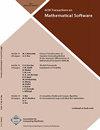IEEE-754 precision-p base-β arithmetic implemented in binary
IF 3.2
1区 数学
Q2 COMPUTER SCIENCE, SOFTWARE ENGINEERING
引用次数: 1
Abstract
We show how an IEEE-754 conformant precision-p base-β arithmetic can be implemented based on some binary floating-point and/or integer arithmetic. This includes the four basic operations and square root subject to the five IEEE-754 rounding modes, namely the nearest roundings with roundTiesToEven and roundTiesToAway, the directed roundings downwards and upwards, as well as rounding towards zero. Exceptional values like ∞ of NaN are covered according to the IEEE-754 arithmetic standard. The results of the precision-p base-β operations are computed using some underlying precision-q binary arithmetic. We distinguish two cases. When using a precision-q binary integer arithmetic, the base-β precision p is limited for all operations by β2p ≤ 2q, whereas using a precision-q binary floating-point arithmetic imposes stronger limits on the base-β precision, namely β2p ≤ 2q for addition and multiplication, β2p ≤ 2q − 1 for division and β2p ≤ 2q − 3 for the square root. Those limitations cannot be improved. The algorithms are implemented in a Matlab/Octave flbeta-toolbox with the choice of using uint64 or binary64 as underlying arithmetic. The former allows larger precisions, the latter is advantageous for the square root, whereas computing times are similar. The flbeta-toolbox offers precision-p base-β scalar, vector and matrix operations including sparse matrices as well as corresponding interval operations. The base β can be chosen in the range β ∈ [2, 64]. The flbeta-toolbox will be part of Version 13 of INTLAB [18], the Matlab/Octave toolbox for reliable computing.用二进制实现的IEEE-754精度-p基-β算术
我们展示了如何在一些二进制浮点和/或整数算法的基础上实现符合IEEE-754的精度-p基-β算法。这包括四个基本运算和服从五种IEEE-754舍入模式的平方根,即具有roundTiesToEven和roundTietToAway的最近舍入、向下和向上的定向舍入以及向零舍入。根据IEEE-754算法标准,NaN的∞等异常值被覆盖。精度-p基-β运算的结果是使用一些基本的精度-q二进制算法计算的。我们区分两种情况。当使用精度为q的二进制整数运算时,所有运算的基本β精度p都受到β2p≤2q的限制,而使用精度为q的二进制浮点运算对基本β精度施加了更强的限制,即加法和乘法的β2p≥2q,除法的β2pp≤2q−1,平方根的β2ps≤2q-3。这些限制是无法改善的。这些算法在Matlab/Octave flbeta工具箱中实现,可以选择使用uint64或binary64作为底层算法。前者允许更大的精度,后者有利于平方根,而计算时间相似。flbeta工具箱提供精确-p基-β标量、向量和矩阵运算,包括稀疏矩阵以及相应的区间运算。基β可以在β∈[2,64]的范围内选择。flbeta工具箱将是INTLAB[18]第13版的一部分,该版本是用于可靠计算的Matlab/Octave工具箱。
本文章由计算机程序翻译,如有差异,请以英文原文为准。
求助全文
约1分钟内获得全文
求助全文
来源期刊

ACM Transactions on Mathematical Software
工程技术-计算机:软件工程
CiteScore
5.00
自引率
3.70%
发文量
50
审稿时长
>12 weeks
期刊介绍:
As a scientific journal, ACM Transactions on Mathematical Software (TOMS) documents the theoretical underpinnings of numeric, symbolic, algebraic, and geometric computing applications. It focuses on analysis and construction of algorithms and programs, and the interaction of programs and architecture. Algorithms documented in TOMS are available as the Collected Algorithms of the ACM at calgo.acm.org.
 求助内容:
求助内容: 应助结果提醒方式:
应助结果提醒方式:


